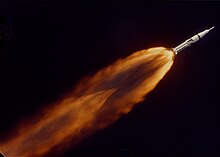
This is a list of all crewed spaceflights throughout history. Beginning in 1961 with the flight of Yuri Gagarin aboard Vostok 1, crewed spaceflight occurs when a human crew flies a spacecraft into outer space. Human spaceflight is distinguished from spaceflight generally, which entails both crewed and uncrewed spacecraft.
There are two definitions of spaceflight. The Fédération Aéronautique Internationale (FAI), an international record-keeping body, defines the boundary between Earth's atmosphere and outer space at 100 kilometres (62 mi) above sea level. This boundary is known as the Kármán line. The United States awards astronaut wings to qualified personnel who pilot a spaceflight above an altitude of 50 miles (80 km).
As of the launch of SpaceX Crew-9 on 28 September 2024, there have been 391 human spaceflight launches. Two missions did not cross either the Kármán line or the U.S. definition of space and therefore do not qualify as spaceflights. These were the fatal STS-51-L (Challenger disaster), and the non-fatal aborted Soyuz mission T-10a. Two aborted missions did cross either the Kármán line or the U.S. definition of space. These were the non-fatal aborted Soyuz mission MS-10 which did not reach the Kármán line but did pass the 80 km (50 mi) line. The other was the non-fatal Soyuz mission, 18a which crossed the Kármán line. Four missions successfully achieved human spaceflight, yet ended as fatal failures as their crews died during the return. These were Soyuz 1, X-15 flight 191, Soyuz 11, and STS-107 (Columbia disaster). Twenty two flights in total reached an apogee beyond 50 miles (80 km), but failed to go beyond 62 miles (100 km), so therefore do not qualify as spaceflights under the FAI definition.